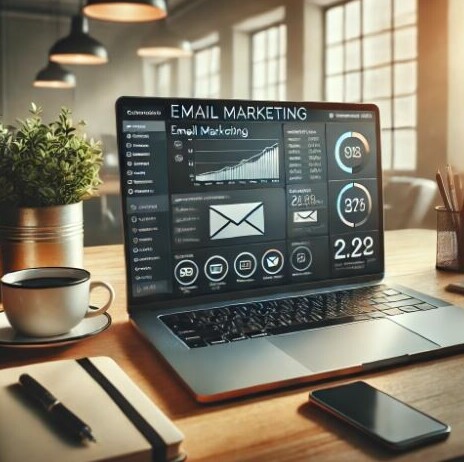Email marketing is a powerful tool that lets you connect directly with your audience in their personal space – their inbox. It’s not just about sending messages but creating meaningful relationships with your subscribers. When done right, it can be one of the most effective ways to drive engagement and conversions.
Numbers don’t lie. Over 4 billion people use email worldwide, and an impressive return on investment (ROI) of $42 for every $1 spent proves it’s worth giving email marketing your full attention. Trends indicate that personalized content and mobile optimization are crucial, ensuring your messages are relevant and accessible to everyone, everywhere.
To nail email marketing, you gotta understand the core principles. First, focus on building trust and delivering value. If your subscribers feel you’re adding something valuable to their lives, they’re more likely to engage. Consistency is key – regular emails keep you top of mind without being spammy. Aim for a mix of informative, promotional, and fun content to keep things fresh.
Knowing your audience is like having a secret weapon. The more you understand their needs, preferences, and behaviors, the better you can tailor your emails to hit the mark. Start by analyzing any data you have and create detailed customer personas. These personas will guide your messaging, helping you craft emails that resonate on a personal level.
Building a High-Quality Email List
A solid email marketing strategy begins with a top-notch email list. Quality over quantity, folks. You want engaged subscribers who are genuinely interested in what you have to offer, not just a big, bloated list of unengaged contacts.
The best email lists grow organically. Avoid buying email lists – it might seem like a quick way to bulk up your numbers, but it often leads to poor engagement and can damage your sender reputation. Instead, focus on nurturing relationships and attracting subscribers through valuable content and enticing incentives.
Subscriber segmentation is like having a personalized conversation with each of your subscribers. By dividing your email list into smaller segments based on behavior, interests, or demographics, you can send targeted emails that speak directly to them. This not only improves engagement but also boosts conversions.

Lead magnets and incentives are your best friends when building an email list. These can be anything from free e-books and exclusive content to discount codes and special offers. The key is to offer something valuable in exchange for an email address. Make sure it’s relevant to your audience to attract the right subscribers.
Maintaining and nurturing your email list is just as important as building it. Regularly clean your list by removing inactive subscribers to keep your engagement rates high. Re-engage those who haven’t interacted in a while with thoughtful campaigns designed to win them back. Always focus on delivering value to keep your subscribers happy and engaged.
Crafting Compelling Email Content
Your email content is where the magic happens. It’s not enough to just send emails; they’ve gotta be engaging and valuable. The goal is to grab attention from the subject line to the call to action.
Subject lines are your first impression. They need to be catchy yet informative. Avoid spammy language and be clear about the email’s purpose. A good subject line creates curiosity and encourages opens. Personalized subject lines can increase open rates significantly.
Inside the email, personalization goes a long way. Use the subscriber’s name, reference their past interactions with your brand, and tailor content to their interests. People want to feel like you’re speaking directly to them, not sending a generic blast.
Design matters too. A visually appealing email keeps readers engaged. Use a clean layout, eye-catching images, and easy-to-read fonts. Mobile optimization is crucial since a majority of emails are opened on mobile devices. Make sure your designs look great on all screen sizes.

A/B testing can take your email content from good to great. Test different elements like subject lines, images, and call-to-action buttons to see what resonates best. Use insights from these tests to continually refine your strategy.
Keeping your emails fresh and varied is key. Mix up your content with educational materials, company news, and special offers. Share stories and testimonials to build credibility and trust. Always aim to provide value and keep your audience wanting more.
Automating and Managing Your Email Campaigns
Email marketing automation is a game-changer. It saves you time, ensures consistency, and nurtures leads without constant manual effort. Think of it as setting up a well-oiled machine that runs smoothly in the background.
There are loads of email automation tools out there, each with unique features. Find one that suits your needs and budget. Look for tools offering robust automation workflows, easy integration with your existing systems, and comprehensive analytics.
Setting up automated email sequences might seem daunting, but it’s super manageable with the right approach. Start with a welcome series for new subscribers—introduce your brand, set expectations, and offer initial value. Follow it up with regular, value-packed emails that keep your audience engaged.

Best practices for campaign management include regularly reviewing your email performance metrics. Track open rates, click-through rates, and conversions to understand what’s working and what’s not. Use this data to tweak your strategy and improve future campaigns.
Monitoring and analyzing email campaign performance is essential. Tools with analytics capabilities can help you dive deep into data. Look beyond basic metrics; consider factors like engagement over time and the impact of different content types. This insight will guide your decisions and help refine your approach.
Maximizing Affiliate Revenue Through Email Marketing
Email marketing can be a gold mine for affiliate marketers when done right. It’s not just about pushing products; it’s about building trust and providing genuine value to your subscribers.
Integrating affiliate offers seamlessly into your email campaigns is an art. Subtlety is crucial here. You want your promotions to feel like a natural recommendation rather than a hard sell. Embed affiliate links in your content naturally, and always disclose affiliations to maintain trust.
Promoting affiliate products effectively involves understanding your audience’s needs and preferences. Craft your email content around these needs, highlighting how the affiliate product can solve a problem or enhance their lives. Share personal experiences or testimonials to boost credibility.

Tracking and measuring the performance of your affiliate links ensures you know what’s working. Most affiliate marketing programs offer tracking tools. Use these insights to tweak your strategies, identifying which products or types of content resonate best with your audience.
Common pitfalls in affiliate email marketing include being overly promotional or not aligning products with your audience’s interests. Avoid bombarding your subscribers with constant sales pitches. Instead, focus on balanced content that educates, entertains, and occasionally promotes.
Real-life examples and case studies can offer inspiration. Look at successful affiliate email marketers and analyze what they’re doing right. This can spark new ideas and strategies for your campaigns. Remember, experimentation is key—find what works best for your unique audience and stick with it.



This article is a goldmine for anyone looking to master email marketing in the world of affiliate marketing! The strategies you’ve shared are not only insightful but also practical for achieving real results. I appreciate how you’ve broken down complex concepts into manageable steps, making it easy for both beginners and experienced marketers to enhance their approach. Thanks for providing such valuable content—this is definitely a must-read for anyone serious about affiliate success!
Thank you so much for your kind words! I’m thrilled to hear that you found the article. My goal was to make email marketing accessible and effective for everyone, so it’s great to know that both beginners and experienced marketers can benefit. Your feedback really motivates me to keep creating content that helps others achieve success in affiliate marketing. Thanks again for reading and sharing your thoughts!